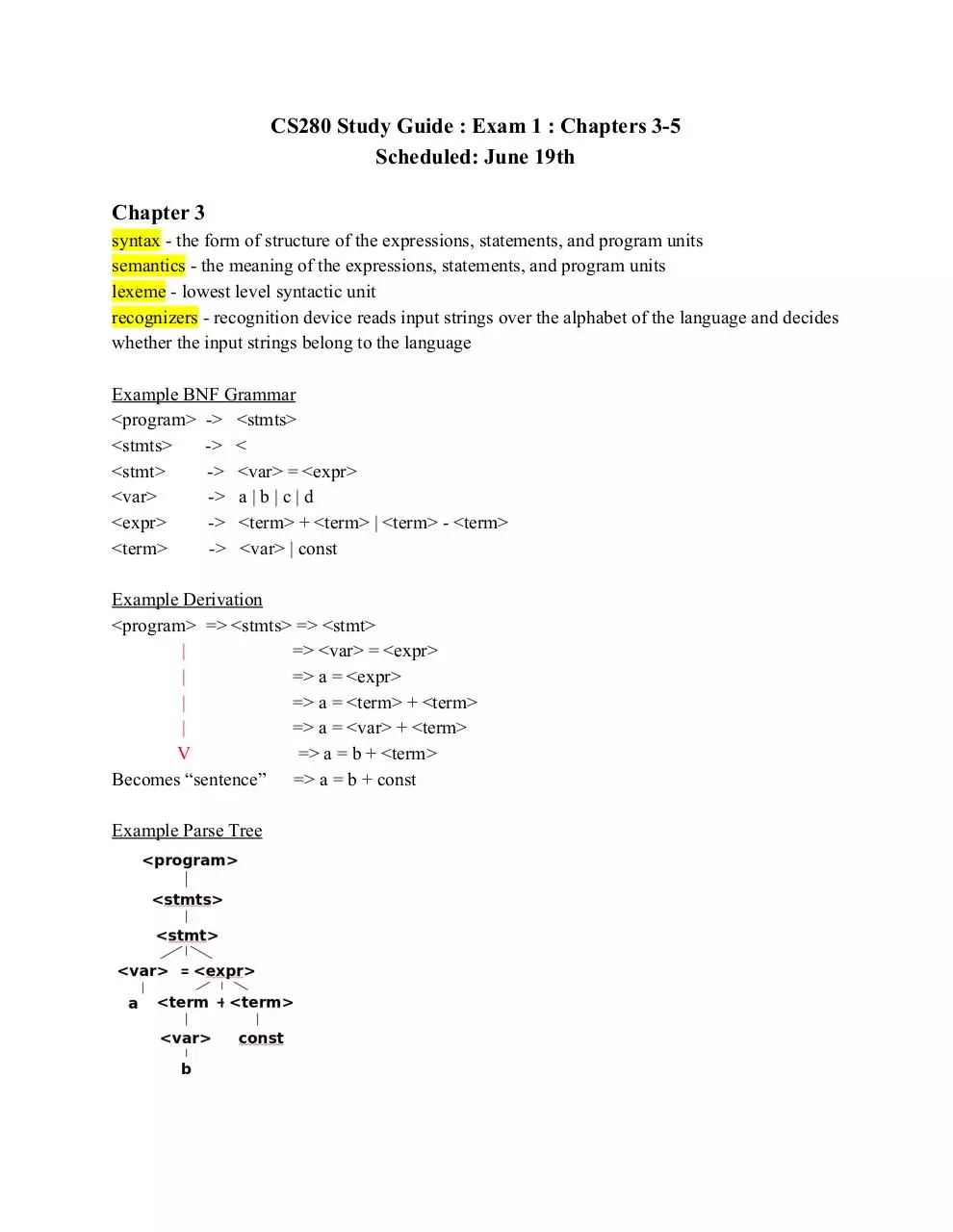CS280StudyGuideExam1Chapters3 5 (PDF)
File information
This PDF 1.5 document has been generated by / Skia/PDF m61, and has been sent on pdf-archive.com on 19/06/2017 at 09:13, from IP address 108.35.x.x.
The current document download page has been viewed 276 times.
File size: 173.53 KB (4 pages).
Privacy: public file




File preview
CS280 Study Guide : Exam 1 : Chapters 3-5
Scheduled: June 19th
Chapter 3
syntax - the form of structure of the expressions, statements, and program units
semantics - the meaning of the expressions, statements, and program units
lexeme - lowest level syntactic unit
recognizers - recognition device reads input strings over the alphabet of the language and decides
whether the input strings belong to the language
Example BNF Grammar
<program> -> <stmts>
<stmts>
-> <
<stmt>
-> <var> = <expr>
<var>
-> a | b | c | d
<expr>
-> <term> + <term> | <term> - <term>
<term>
-> <var> | const
Example Derivation
<program> => <stmts> => <stmt>
|
=> <var> = <expr>
|
=> a = <expr>
|
=> a = <term> + <term>
|
=> a = <var> + <term>
V
=> a = b + <term>
Becomes “sentence” => a = b + const
Example Parse Tree
A grammar is ambiguous if and only if it generates a sentential form(“sentence”) that has two or
more distinct parse tree.
Difference between BNF and EBNF: (basically more complex w/ more customization)
- EBNF has optional parts placed in brackets [ ]
- EBNF has alternative parts placed in parentheses ( + | - )
- EBNF has repetitions (0 or more) placed in braces: <ident> -> letter {letter | digit}
Grammars are well-suited for describing the syntax of programming languages.
Attribute grammar is a descriptive grammar that can describe both the syntax and the semantics
of a language.
Three primary methods of semantic description:
- Operation
- Axiomatic
- Denotational
operational - state changes are defined by coded algorithms
denotational - state changes are defined by rigorous mathematical functions
Chapter 4
If a grammar has left recursion, either direct or indirect, it cannot be the basis for a top down
parser.
Useful parsers only look one token ahead.
Top-Down Parser
The parser must choose the correct rule in the leftmost derivation using only the first token
produced.
Produces a parse tree that begins at the root and ends with the leaves.
Lexical analysis is the first phase of a compiler. Takes code in form of sentences. The lexical
analyzer breaks these down to tokens (removing any whitespace or comments.)
Syntax analysis, or parser, takes the input from a lexical analyzer in form of token streams.
Checks for errors. Output is a parse tree.
A recursive-descent parser is an LL parser (EBNF.)
Parsing Problem (Bottom-up) - find the substring of current sentential form
LR family of shift-reduce parsers is the most common bottom-up parsing approach.
State Diagram (example)
Chapter 5
binding - is an association between an entity and an attribute, such as between an operation and a
symbol
Binding is the association of attributes with program entities.
binding time - the time at which a binding takes place
static - if binding occurs before runtime and remains unchanged throughout program execution
dynamic - if binding occurs during execution or can change during execution of the program
scope - of a variable is the range of statements over which it is visible
Variables are characterized by:
- Name, address, value, type, lifetime, scope
Scalar Variables:
- Static, stack dynamic, explicit heap dynamic, implicit heap dynamic
Strong typing means detecting all type errors.
Compile time vs. Runtime
The source code must be compiled into machine code in order to become an executable program.
The compilation process is referred to as compile time. A compiled program can be opened and
run by a user. When an application is running, it is called runtime.
Download CS280StudyGuideExam1Chapters3-5
CS280StudyGuideExam1Chapters3-5.pdf (PDF, 173.53 KB)
Download PDF
Share this file on social networks
Link to this page
Permanent link
Use the permanent link to the download page to share your document on Facebook, Twitter, LinkedIn, or directly with a contact by e-Mail, Messenger, Whatsapp, Line..
Short link
Use the short link to share your document on Twitter or by text message (SMS)
HTML Code
Copy the following HTML code to share your document on a Website or Blog
QR Code to this page

This file has been shared publicly by a user of PDF Archive.
Document ID: 0000613801.